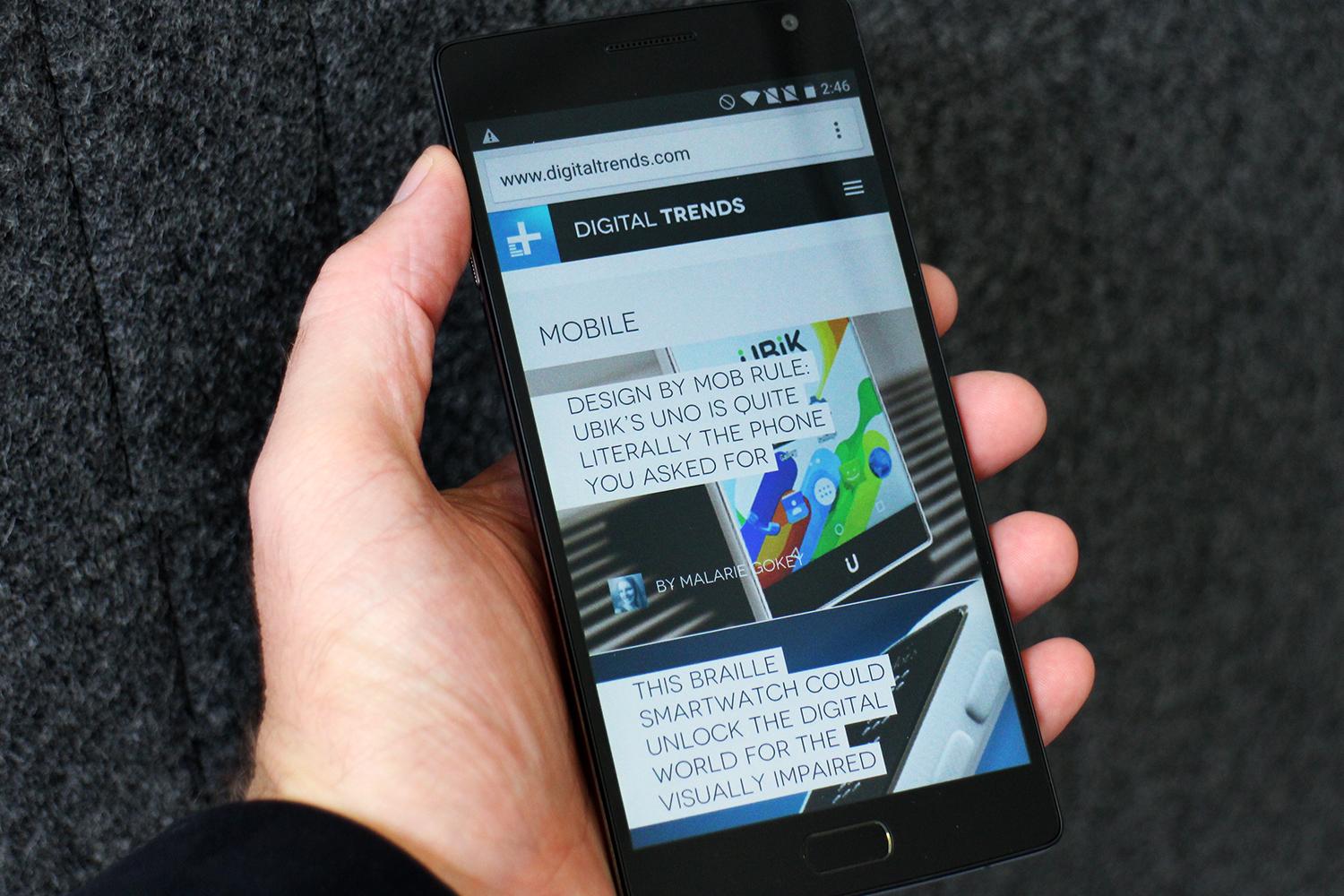
“Like the Nexus 5, the OnePlus 2 is frill-free and thrill-free.”
- Well priced
- Snapdragon 810 power
- Premium build quality
- Almost stock Android
- Fast fingerprint scanner
- Camera app needs improvement
- Battery life didn’t impress
- Dull styling
- No NFC or MicroSD card
In 2014, only the hardcore smartphone fan had heard of OnePlus. The rest of the world busied itself buying devices from Samsung, LG, and Apple — just like usual. In 2015, thanks to a strong marketing campaign for the One and a deeply committed fan base, OnePlus has found itself with a legion of new admirers lining up for the opportunity to buy the OnePlus 2 — a smartphone it describes as the 2016 flagship killer. It’s so good, apparently, it’s beating phones that haven’t even been revealed yet.
Buy it now from:
It’s a big statement, even for the bluster-masters at OnePlus. First impressions from a few hours with the OnePlus 2 were good, but now we’ve had the chance to spend a few weeks with the phone. Has everything changed? After all, the OnePlus One revealed itself to be more than a little temperamental. Would its successor suffer from the same problems? Here’s what it has been like to live with the OnePlus 2.
Metal, glass, and sandpaper make up the OnePlus 2
The OnePlus 2 isn’t the thinnest, the lightest, nor the best-looking smartphone you can buy. However, it’s one of the cheapest flagship phones with high-end specs available. Only the Moto X Style offers comparable specs at a similar price point. The chassis is built from metal, and there’s a neat chamfer around the edge, which catches the light when the phone is face up on the table. It all feels strong, tough, and well built — like a phone that’s going to last.
Out of the box, the OnePlus 2 has a textured rear cover made from plastic and what feels like sandpaper. The texture provides plenty of grip, and the matte finish looks very modern, especially as only the metal ring around the
That scratchy back’s a love-it-or-hate it affair, and it’s a world apart from the soft leather LG G4, or the cool smoothness of an iPhone 6. Luckily, OnePlus offers several replacement rear covers in a variety of unusual and more tactile materials that should jazz up the slightly dull exterior nicely.
A single piece of Gorilla Glass 4 covers the 5.5-inch display, and if you place the phone face down on the table, it touches the surface — so watch out for possible scratches. The phone weighs 175 grams, which is heavier than the Galaxy S6 and the
Notification slider and USB Type-C charging
There are two uncommon features on the OnePlus 2’s body. The first is a physical slider switch on the left-hand side to adjust the notification alerts. The switch simplifies one of Android’s most recent new additions — accept all notifications, alarms, or only priorities — and ends the need to dig around in the menu to customize the alert level. It’s a little like the mute switch on the iPhone, but far more useful.
The other is a USB Type-C connection for charging. It’s reversible, so it’s easy to plug in the charging cable each and every time. The cable itself is bright red with white connections. It’s good that it’s so noticeable, because the OnePlus 2 is probably the only device in your house that uses USB Type-C. If you lose it, the Micro USB cable you used to charge your last phone won’t come to the rescue.
The specs are outstanding for the price
Judged solely on style, the OnePlus 2 isn’t going to win hearts in the same way as the best phones from Samsung and HTC. While it’s not a featureless brick, don’t expect anyone to ohh and ahh when you flash it around.
However, you will get some raised eyebrows after you mention the price. It’s $330 for the 16GB or $390 for the 64GB model, and that’s about half what you’ll pay for other big-name, high-spec phones. For that price, you get a 1080p 5.5-inch screen that’s very bright and rarely suffers from having a lower pixel count than the G4 or the Galaxy S6. The only time I missed having a Quad HD screen was when I examined photos I’d just taken. A higher-resolution screen shows off more detail than you get with 1080p.
It’s so good, apparently, it’s beating phones that haven’t even been revealed yet.
The power comes from the much-maligned Snapdragon 810 processor. Due to concerns about overheating, Samsung avoided the 810 and used it’s own processors in the Galaxy S6, Note 5, and S6 Edge Plus. Although the 810 powers LG’s G Flex 2 and Sony’s Xperia Z3+, it’s not the most trustworthy processor around. So, how is it inside the OnePlus 2? Since OnePlus used the revised version of the 810, it doesn’t try to roast you alive, but it can still get toasty. The OnePlus 2 never gets to the point where it’s uncomfortable to hold, but you will notice the heat.
The new 810 runs at 1.5GHz, according to Geekbench 3, which is the same speed as the G Flex 2, but the processor comes with a whopping 4GB of
In the real world, the OnePlus 2 is very smooth and fast, and that’s mainly thanks to OxygenOS, OnePlus’ version of Android 5.1, which has minimal changes over the stock version of
One of the major alterations is Shelf, a collection of shortcuts and handy tools that you can access with a right swipe from the home screen. You can customize it with widgets, and Shelf houses a list of your ten most frequently used apps. I never found a reason to use it all the time, but quick access to my favorite apps was helpful. Likewise, the ability to change around the tools in the notification tray was helpful once (maybe), but never again.
Fingerprints and hardware keys
OxygenOS is not 100-percent reliable though, and will crash badly if provoked. For example, using the shortcut to the camera from the lockscreen, then letting the screen sleep again confused it terribly, often requiring a soft reset to get things going again. Otherwise, OxygenOS is just like using regular
The OnePlus 2 has a fingerprint sensor in the home button, but it doesn’t need to be pressed like an iPhone, instead it stays in a fixed position. It’s used for securing the phone at the moment, but don’t expect it to come in handy for all types of mobile payments in the future, because the OnePlus 2 doesn’t have NFC.
Set up correctly, the fingerprint sensor can wake and unlock the phone from a black sleep screen in less time that the equivalent process on the iPhone with Touch ID. It’s flanked by Android’s back and overview keys. Which one’s which? You’ve got to guess, because they’re marked by lines rather than symbols. You get used to it, but anyone new to
Strong camera, but surprisingly weak battery
So far, the OnePlus 2 sounds good, but it’s not quite the flagship killer OnePlus claims. Can the camera and the battery make the difference?
There’s a 13-megapixel camera on the back, which comes with an LG-style laser autofocus and a dual-LED flash. The app icon makes it look like a standard Google camera app, but it’s slightly reworked by OnePlus, with an
I only got through 48 hours with low usage and a lot of screen-off standby.
However, the results are mixed. Point it at a landscape on a decent day, and it does a good job, especially with the
I missed a dedicated gallery app, like the one on the G4, and flicking through the pictures using the camera app proved annoying. If you dare to zoom in for a closer look, there’s no way to slide to the next image. You can only return to the camera screen. There’s also a weird effect over some images when you view them in the camera app. It looks like a piece of lace has been draped over the top of the image. It’s odd, but something that’ll inevitably be fixed in a software update.
The battery certainly improved with an update, but even then under medium to heavy use — gaming, benchmarks, some VR video, social networking, and connecting with a smartwatch — it would be down to its last 10-percent in just 14 hours. The 3,300mAh battery and 1080p screen gave me hope that the OnePlus 2 would laugh at two-days of use, but I only got through 48 hours with low usage and a lot of screen-off standby. Further software updates could improve the battery efficiency, though. It’s also unfortunate there’s no fast charging system, and the OnePlus 2 takes nearly three hours to go from zero to 100-percent.
Sound bad? It’s not
There is absolutely nothing wrong with the OnePlus 2. It’s like the Nexus 5 — frill-free, but also thrill-free. It does everything you could want, just not in a particularly stunning manner. I never tingled with excitement when using it, there are some feature omissions that are unfortunate, and most people I showed it to were decidedly underwhelmed. That is, until I told them the price. That’s the only aspect that makes the OnePlus 2 a flagship killer. It has nothing at all to do with specs, and everything to do with how little it costs.
Should you buy one? You’re unlikely to be disappointed if you do.
The low price point makes the phone impossible to ignore, and it’s difficult to chastise OnePlus too harshly over the lack of fast charging,
Should you buy one? You’re unlikely to be disappointed if you do. The OnePlus 2 doesn’t seem to suffer from any of the original’s problems, but to get it, you’ll have to endure the irritating invitation system. The OnePlus 2 is an enthusiast’s phone, and you’ll have to be pretty damn enthusiastic to bag one. You can grab every other phone off the shelf without jumping through any hoops, and some like the Moto X Style are just as well priced and match the OnePlus 2 spec for spec. The $400 Moto X Style even trumps the OnePlus 2 with a Quad HD screen, a 21-megapixel camera, and fast charging.
The DT Accessory Pack
Up your game and the get the most out of your gear with the following extras, hand-picked by our editors:
OnePlus 2 StyleSwap Cover ($27)
OnePlus 2 Flip Cover ($20)
Ultimately, the OnePlus 2 is a Snapdragon 810-powered, 5.5-inch, almost stock
Highs
- Well priced
- Snapdragon 810 power
- Premium build quality
- Almost stock Android
- Fast fingerprint scanner
Lows
- Camera app needs improvement
- Battery life didn’t impress
- Dull styling
- No NFC or MicroSD card




























